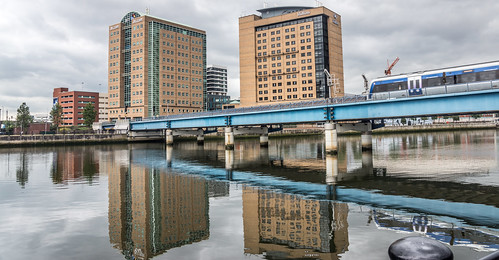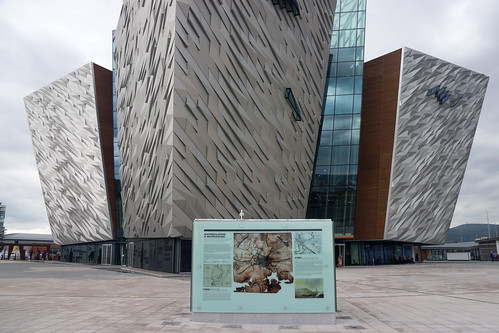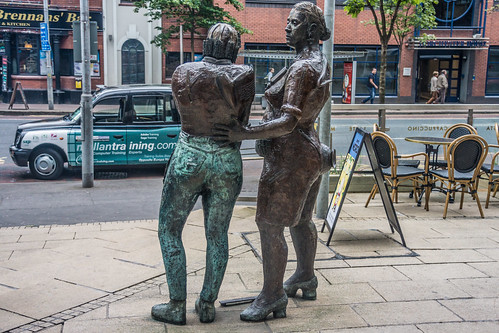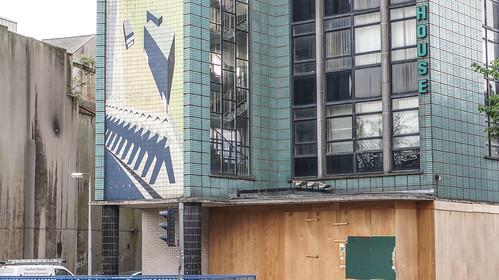
The Lagan Railway Bridge & Footbridge In Belfast - Northern Ireland, a photo by infomatique on Flickr.

Titanic Belfast is an iconic six-floor building featuring nine interpretive galleries. The building also houses temporary exhibits, a 1000-seater banqueting suite, education and community facilities, catering and retail space and a basement car park. Visitors will learn about the construction of RMS Titanic and the wide and rich story of Northern Ireland’s industrial and maritime heritage.
Supported by the Northern Ireland Executive, Titanic Belfast is a unique public / private partnership funded by the Northern Ireland Tourist Board, Belfast City Council, Belfast Harbour and Titanic Quarter Ltd. It is operated by Titanic Belfast Ltd and will be owned by the Titanic Foundation Ltd.
Titanic Belfast's nine interpretative and interactive galleries explore the sights, sounds, smells and stories of Titanic, as well as the city and people which made her. Visitors will journey - by foot and by rides - through:
• Boomtown Belfast
• The Arrol Gantry & Shipyard Ride
• The Launch
• The Fit Out
• The Maiden Voyage
• The Sinking
• The Aftermath
• Myths & Legends
• Titanic Beneath (including the Ocean Exploration Centre)

Titanic Belfast is an iconic six-floor building featuring nine interpretive galleries. The building also houses temporary exhibits, a 1000-seater banqueting suite, education and community facilities, catering and retail space and a basement car park. Visitors will learn about the construction of RMS Titanic and the wide and rich story of Northern Ireland’s industrial and maritime heritage.
Supported by the Northern Ireland Executive, Titanic Belfast is a unique public / private partnership funded by the Northern Ireland Tourist Board, Belfast City Council, Belfast Harbour and Titanic Quarter Ltd. It is operated by Titanic Belfast Ltd and will be owned by the Titanic Foundation Ltd.
Titanic Belfast's nine interpretative and interactive galleries explore the sights, sounds, smells and stories of Titanic, as well as the city and people which made her. Visitors will journey - by foot and by rides - through:
• Boomtown Belfast
• The Arrol Gantry & Shipyard Ride
• The Launch
• The Fit Out
• The Maiden Voyage
• The Sinking
• The Aftermath
• Myths & Legends
• Titanic Beneath (including the Ocean Exploration Centre)
Belfast Harbour (also Port of Belfast) is a major maritime gateway in Northern Ireland, serving the Northern Ireland economy and increasingly that of the Republic of Ireland. With almost 1.2 million passengers and half a million freight units annually, Belfast is Ireland's second largest maritime gateway.
It is a major centre of industry and commerce and has become established as the focus of logistics activity for Northern Ireland. Around two thirds of Northern Ireland's seaborne trade, and a quarter of that for Ireland as a whole, is handled at the port which receives over 6000 vessels each year. The Port of Belfast is located at the centre of Northern Ireland’s largest industrial and commercial zone with two thirds of the region’s major industrial employers located within 15 km of the Port.
It is Ireland's leading dry bulk port, dominating the market with regard to imports of grain and animal feeds, coal, fertilisers and cement. Over 95% of Northern Ireland's petroleum and oil products are also handled at the Port.
The gardens opened in 1828 as the private Royal Belfast Botanical Gardens. It continued as a private park for many years, only opening to members of the public on Sundays prior to 1895. Then it became a public park in 1895 when the Belfast Corporation bought the gardens from the Belfast Botanical and Horticultural Society. The Belfast Corporation was the predecessor of Belfast City Council, the present owner.
Dreams consists of forty large metal panels in a grid formation, which is etched with portraits of a group of children.
The centre of each section, formed in glass and back-lit, glow at night holding the dreams of 9,000 local children.
The project fuses together a strong sense of our metal crafting heritage and the spirit of our children's ability to dream.
Rita is one of Ireland's foremost artists having exhibited widely internationally.
Her recent work Banquet was displayed in the Ormeau Baths Gallery, Belfast and Hugh Lane Gallery, Dublin. Her work features in public and private collections in Ireland, USA and Europe. Rita is currently working on a public artwork for O'Connell Street, Dublin.
Chosen by public vote, the Spirit of Belfast in Belfast City Centre was created by New York artist Dan George.
The seven metre high sculpture is composed of four curved stainless steel structural elements including lighting and is installed on a granite plinth base.
In the artist's words: "The Spirit of Belfast is the manifestation of our energy as we look to the future as well as a meditation on our past. It is a timepiece that weaves together the strength of steel and the delicacy of light, ocean liners and linen, progress and peace".
New York artist Dan George creates large scale installations and sculpture.

The two bronze female figures address the issues of women's low-paid jobs and unpaid housework. This theme is articulated by the use of objects and utensils symbolic of women's work, such as household items, telephones, shopping baskets and cash registers.
Louise Walsh was born in County Cork in 1963 and graduated from Crawford Municipal College of Art in 1985. She gained an MA in Sculpture from the University of Ulster, Belfast in 1986.
She is well known for her life-size portrayals which challenge conventional depictions of women, her use of informal objects and her technical skills. She has exhibited extensively in Ireland and the UK and has substantial experience in the field of public art.

Transport House is the Belfast headquarters of the Amalgamated Transport and General Workers’ Union. Built in 1959, in the International Style, it has become the focal hub of the Province’s trade union movement, and one of Northern Ireland’s youngest listed buildings. Historic Buildings and Monuments, in its 1994 schedule, described Transport House as “…a very assertive building – dramatic in its impact, exhibiting a range of modernist features in a well worked out scheme…”
This 8.5 metre long ship outline is made of translucent blue cobbles surrounded by a cast iron frame. The cobbles have starfish embedded within to suggest sea and sky and are lit from underneath with fibre optic lighting.
Rachel Joynt was born in County Kerry in 1966. She has a degree in sculpture from the National College of Art and Design, Dublin.
She has been involved in the creation of many public artworks in Ireland including People's Island, Dublin Millennium Sculptural Symposium, Perpetual Motion, Naas by-pass and Shoreline, Derry City Council.
The railing panel depicts a shoal of fish caught in a trawler's fishing net. The net is completed in mild steel with the fish and trawler made in mosaic tile.
Michael Baker has a BA and MA in Fine Art. He is an experienced teacher and community-based artist. His work involves sculpture and clay modelling, mosaic, float and prop making, festival and costume design.

This representation of a cooper on his barrel was commissioned by Bass Ireland to celebrate their 100th anniversary of brewing in Belfast. It marks the important role the Ulster Brewery, its people and brands have played in the community over 100 years.
Ross Wilson graduated with a first-class honours degree in Fine Art from the University of Ulster and received his masters from the prestigious Chelsea School of Art, London.
He has had many solo exhibitions and has been included in group exhibitions worldwide. In 1998, his bronze sculpture of CS Lewis was placed at the Hollywood Arches, Belfast.
The design represents the many winding roads in Ireland with the imprint of cycle tyres along the lanes.
David Dudgeon has an MA in Applied Arts and a BA in Product Design. His work to date has involved the link between functional design and sculpture. Other commissions include sculptural benches for the Royal Children's Hospital.
The gardens opened in 1828 as the private Royal Belfast Botanical Gardens. It continued as a private park for many years, only opening to members of the public on Sundays prior to 1895. Then it became a public park in 1895 when the Belfast Corporation bought the gardens from the Belfast Botanical and Horticultural Society. The Belfast Corporation was the predecessor of Belfast City Council, the present owner.

‘Alec the Goose (and friend)’ sculpture, which is based on a popular goose who waddled around the south Belfast area in 1929.

I have never visited this area of Belfast before and I must say that I liked the fact the Queen's University, The Botanic Gardens and the Ulster Museum are located beside each other.
The Gardens are attractive but they do not really compare with the Botanic Gardens in Dublin as they are much smaller and while I was there the place was too crowded for my liking. There were many notices indicating that the consumption of alcohol is banned but I certainly saw a number youths drinking beer.
According to Wikipedia: "Belfast Botanic Gardens is a public park in Belfast, Northern Ireland. Occupying 28 acres (110,000 m²) of south Belfast, the gardens are popular with office workers, students and tourists. They are located on Stranmillis Road in Belfast's university area, with Queen's University nearby. The Ulster Museum is located at the main entrance."
The gardens opened in 1828 as the private Royal Belfast Botanical Gardens. It continued as a private park for many years, only opening to members of the public on Sundays prior to 1895. Then it became a public park in 1895 when the Belfast Corporation bought the gardens from the Belfast Botanical and Horticultural Society. The Belfast Corporation was the predecessor of Belfast City Council, the present owner.
The gardens' most notable feature is the Palm House conservatory. The foundation stone was laid by the Marquess of Donegall in 1839 and work was completed in 1840. It is one of the earliest examples of a curvilinear cast iron glasshouse in the world. Designed by Charles Lanyon and built by Richard Turner, Belfast's Palm House predates the glasshouses at Kew and the Irish National Botanic Gardens at Glasnevin. Turner went on to build both of these glasshouses. The Palm House consists of two wings, the cool wing and the tropical wing which contains the dome. Lanyon altered his original plans to increase the height of the dome, allowing for much taller plants. In the past these have included an 11 metre tall Globe Spear Lily. The lily, which is native to Australia, finally bloomed in March 2005 after a 23 year wait. The Palm House also features a 400 year old Xanthorrhoea.
The gardens also contain another glasshouse, the Tropical Ravine House. Built by head gardener Charles McKimm in 1889, it features a unique design. A sunken ravine runs the length of the building, with a balcony at each side for viewing. The most popular attraction is the Dombeya, which flowers every February.
The Palm House and the Tropical Ravine House were symbols of Belfast's growing industrial might and prosperity in the Victorian era and attracted over 10,000 visitors a day. The gardens also feature one of the longest herbaceous borders in the UK and Ireland. The is also a rose garden built in 1932 and various species of tree, including the hornbeam-oak. A statue of Lord Kelvin stands at the Stranmillis Road entrance.
I have never visited this area of Belfast before and I must say that I liked the fact the Queen's University, The Botanic Gardens and the Ulster Museum are located beside each other.
The Gardens are attractive but they do not really compare with the Botanic Gardens in Dublin as they are much smaller and while I was there the place was too crowded for my liking. There were many notices indicating that the consumption of alcohol is banned but I certainly saw a number youths drinking beer.
According to Wikipedia: "Belfast Botanic Gardens is a public park in Belfast, Northern Ireland. Occupying 28 acres (110,000 m²) of south Belfast, the gardens are popular with office workers, students and tourists. They are located on Stranmillis Road in Belfast's university area, with Queen's University nearby. The Ulster Museum is located at the main entrance."
The gardens opened in 1828 as the private Royal Belfast Botanical Gardens. It continued as a private park for many years, only opening to members of the public on Sundays prior to 1895. Then it became a public park in 1895 when the Belfast Corporation bought the gardens from the Belfast Botanical and Horticultural Society. The Belfast Corporation was the predecessor of Belfast City Council, the present owner.
The gardens' most notable feature is the Palm House conservatory. The foundation stone was laid by the Marquess of Donegall in 1839 and work was completed in 1840. It is one of the earliest examples of a curvilinear cast iron glasshouse in the world. Designed by Charles Lanyon and built by Richard Turner, Belfast's Palm House predates the glasshouses at Kew and the Irish National Botanic Gardens at Glasnevin. Turner went on to build both of these glasshouses. The Palm House consists of two wings, the cool wing and the tropical wing which contains the dome. Lanyon altered his original plans to increase the height of the dome, allowing for much taller plants. In the past these have included an 11 metre tall Globe Spear Lily. The lily, which is native to Australia, finally bloomed in March 2005 after a 23 year wait. The Palm House also features a 400 year old Xanthorrhoea.
The gardens also contain another glasshouse, the Tropical Ravine House. Built by head gardener Charles McKimm in 1889, it features a unique design. A sunken ravine runs the length of the building, with a balcony at each side for viewing. The most popular attraction is the Dombeya, which flowers every February.
The Palm House and the Tropical Ravine House were symbols of Belfast's growing industrial might and prosperity in the Victorian era and attracted over 10,000 visitors a day. The gardens also feature one of the longest herbaceous borders in the UK and Ireland. The is also a rose garden built in 1932 and various species of tree, including the hornbeam-oak. A statue of Lord Kelvin stands at the Stranmillis Road entrance.